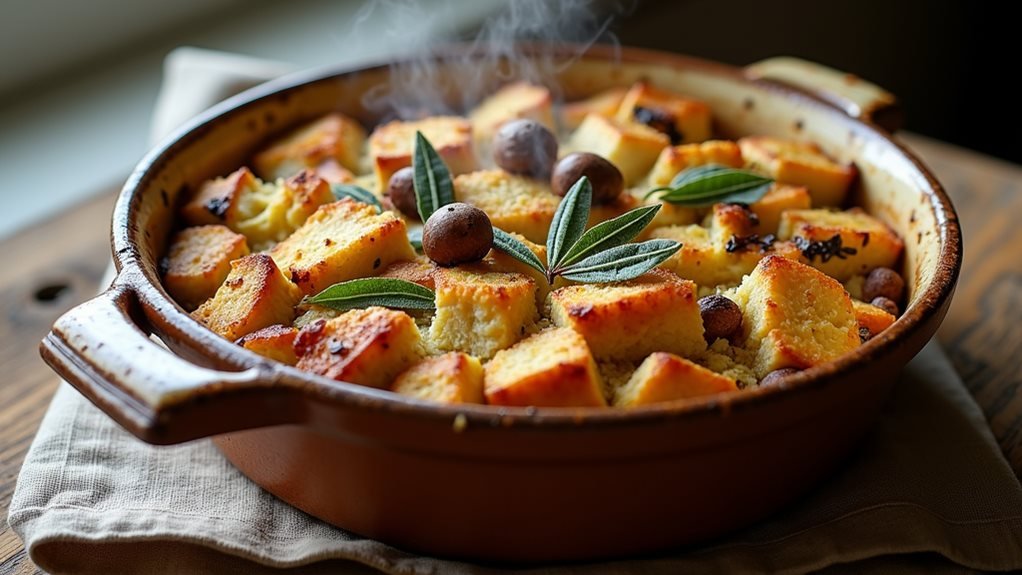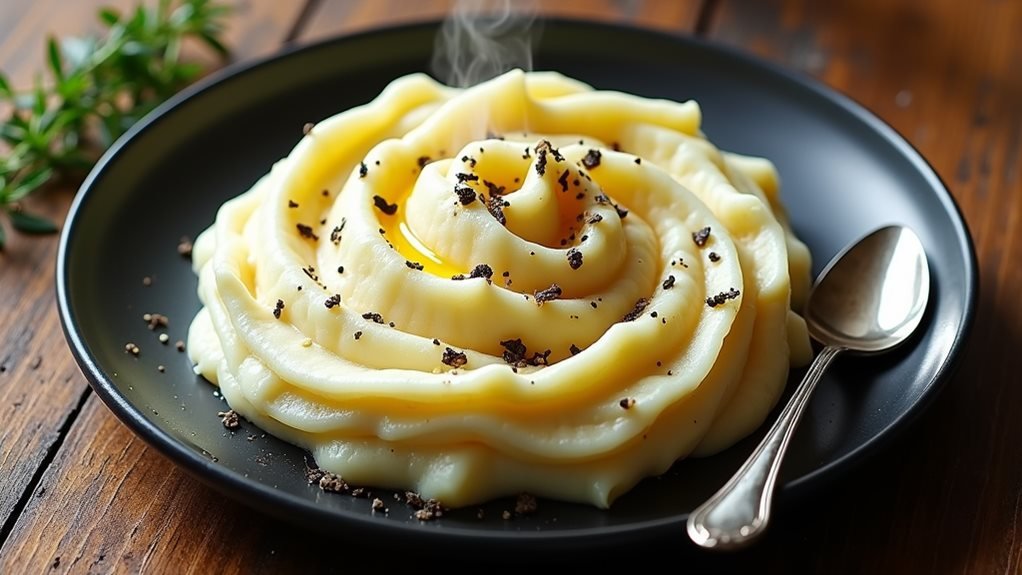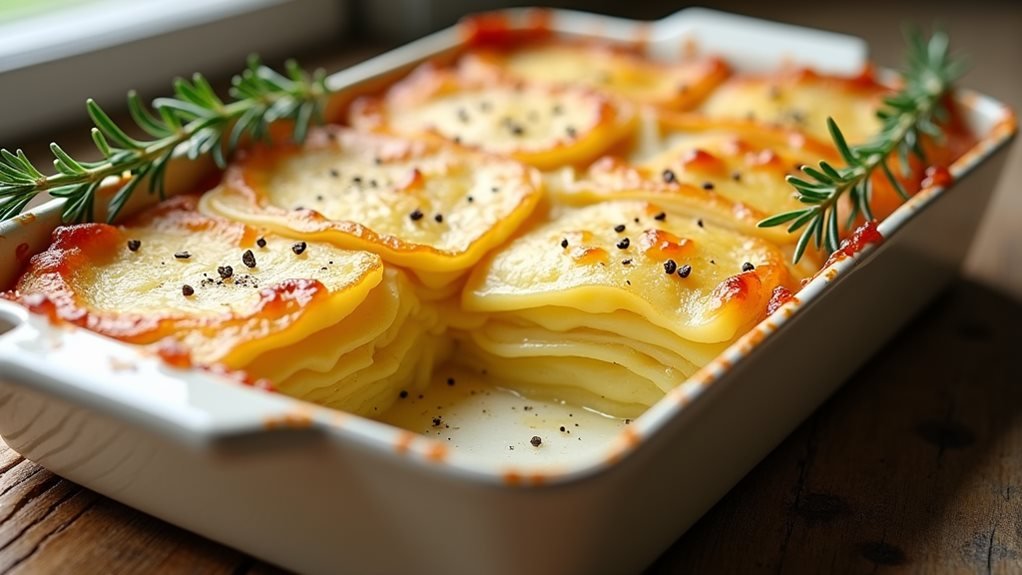Have you ever wondered how a humble bread stuffing could evolve into a masterpiece worthy of a Michelin-starred restaurant? You’ll unveil that Gordon Ramsay’s approach to chestnut and sage sourdough stuffing enhances this classic dish from a simple side to a showstopping holiday essential. By combining the earthy depth of roasted chestnuts with the aromatic beauty of fresh sage and perfectly toasted sourdough, you’re not just making stuffing – you’re creating a sophisticated interpretation of comfort food that’ll have your guests reaching for another helping. Let’s delve into how you can master this refined version of a beloved holiday tradition.
Recipe Insights
- Crisp the sage leaves until fragrant to infuse butter with sage, then strain and reserve both the butter and crispy leaves.
- Toast sourdough cubes in sage butter until golden brown, ensuring even coating and crisp edges.
- Score chestnuts in an X pattern, roast until tender, then peel and roughly chop while still warm.
- Layer ingredients with proper seasoning between each addition, emphasizing bold flavors characteristic of Ramsay’s style.
- Bake at high heat (400°F) initially covered, then uncovered for a crispy top and moist interior.
History
While stuffing has been a cornerstone of holiday meals since ancient times, the combination of sourdough and chestnuts gained popularity in 19th-century San Francisco during the Gold Rush era. Local bakers developed distinctive sourdough techniques using wild yeast strains unique to the region, while Italian immigrants introduced the tradition of roasting chestnuts on street corners.
This fusion of European and American culinary traditions created a stuffing variation that’s distinctly Californian. The readily available wild chestnuts from the Sierra Nevada foothills provided sustenance for miners, while sourdough became the city’s signature bread. By the 1870s, you’d commonly see this combination appearing on holiday tables throughout the Bay Area.
The addition of sage to this mixture reflects the herb’s long-standing role in traditional stuffing recipes, dating back to Roman times. Modern chefs like Gordon Ramsay often enhance their recipes with an oil-vinegar ratio of 3:1 to create perfect vinaigrettes for drizzling.
The modern version of this dish dates back to the early 1900s when professional chefs began documenting specific measurements and techniques, transforming what was once a rustic preparation into the refined side dish you’ll serve today.
Recipe
This rustic stuffing combines the robust flavor of sourdough bread with the sweet, earthy notes of roasted chestnuts and aromatic sage. The combination creates a sophisticated twist on traditional stuffing that’s both comforting and elegant, perfect for holiday gatherings or special occasions.
The success of this dish relies on the careful balance of textures – crispy edges, tender middle, and the meaty bite of chestnuts throughout. The sourdough bread provides a tangy foundation that complements the subtle sweetness of the chestnuts, while fresh sage adds an herbaceous note that ties all the flavors together.
- 1 large loaf of day-old sourdough bread, cubed
- 2 cups roasted chestnuts, roughly chopped
- 1/4 cup fresh sage leaves
- 1 cup unsalted butter
- 2 cups chicken stock
- Salt and pepper to taste
Melt butter in a large skillet over medium heat until foamy, then fry sage leaves until crispy and remove them. Add bread cubes to the butter and toast until golden brown, then transfer to a large baking dish. Mix in the chopped chestnuts and crumble the crispy sage over top. Season with salt and pepper, then pour warm chicken stock evenly over the mixture. Cover with foil and bake at 375°F for 30 minutes; remove foil and continue baking for 15 minutes until the top is golden brown and crispy.
For best outcomes, make sure your bread is thoroughly dried out before beginning – fresh bread will result in a mushy texture. Monitor the moisture level as you add the stock, as different breads have varying absorption rates. The stuffing can be assembled up to 24 hours in advance and refrigerated before baking, though you may need to increase the cooking time slightly if baking straight from the refrigerator. Similar to gradual stock addition in risotto, the careful incorporation of liquid ensures the perfect texture in this stuffing.
Cooking Steps
You’ll begin by roasting your chestnuts until tender and toasting the sourdough cubes in sage-infused butter until golden brown.
Next, you’ll combine these ingredients in a baking dish, making sure the crispy sage and chestnuts are evenly distributed throughout the bread.
Lastly, you’ll bake the stuffing in two stages: initially covered with foil to lock in moisture, then uncovered to achieve that perfect crispy top layer.
Step 1. Prepare Chestnuts by Roasting
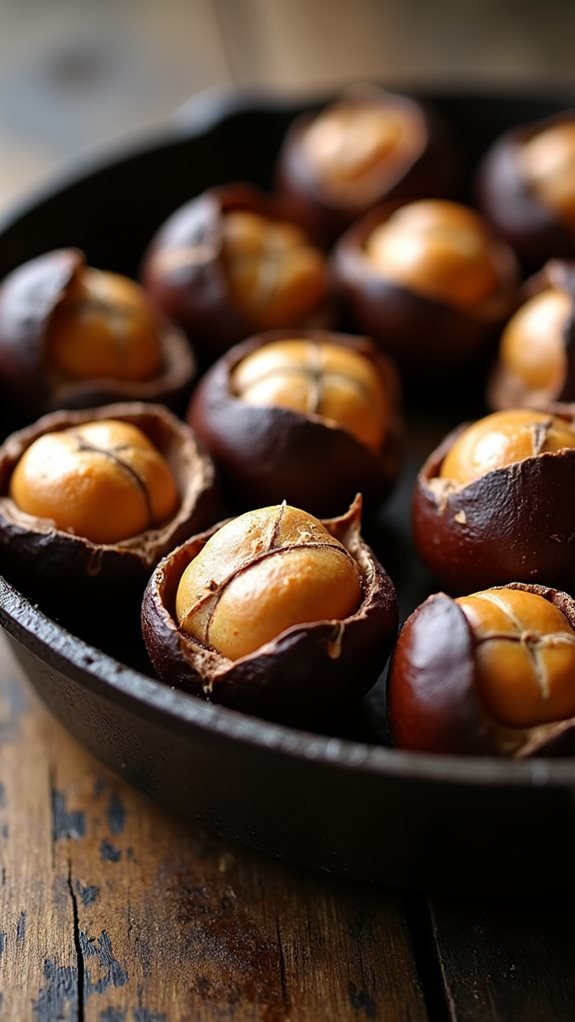
Before incorporating chestnuts into your stuffing, they’ll need proper roasting to develop their sweet, nutty flavor. Start by scoring an X on the flat side of each chestnut with a sharp knife, making sure to cut through the shell but not too deeply into the flesh. This vital step prevents them from exploding during the roasting process.
Arrange the scored chestnuts on a baking sheet, X-side up, and roast them in a preheated 425°F oven for 20-25 minutes. You’ll know they’re done when the shells have darkened and curled back at the X marks.
While the chestnuts are still warm, wrap them in a clean kitchen towel for 5 minutes—this steaming makes peeling easier. Working quickly, peel away both the hard outer shell and the inner skin while the chestnuts are still warm. If they cool too much, they’ll become difficult to peel.
Once peeled, roughly chop the chestnuts into bite-sized pieces. Don’t worry if some break apart unevenly – this adds textural interest to your stuffing.
Step 2. Toast-Bread With Sage Butter

With your roasted chestnuts prepared, start the next key step of infusing rich sage flavor into the bread cubes. Place a large, heavy-bottomed skillet over medium heat and add the unsalted butter. Once it’s melted and starts to foam, carefully add your fresh sage leaves, allowing them to crisp up for 2-3 minutes until they’re fragrant but not burned. Remove the crispy sage leaves and set them aside.
Now, working in batches, add your day-old sourdough cubes to the sage-infused butter. Toast them until they’re golden brown on all sides, turning them frequently with a wooden spoon or spatula. Don’t overcrowd the pan—you need space between the cubes to achieve that perfect toasted exterior. As each batch finishes, transfer the bread to your waiting baking dish.
Once all the bread is toasted, crumble the reserved crispy sage leaves over the top. This method guarantees that every piece of bread gets coated in aromatic butter while developing a crust that’ll hold up beautifully when the stock is added later.
Step 3. Combine All Ingredients
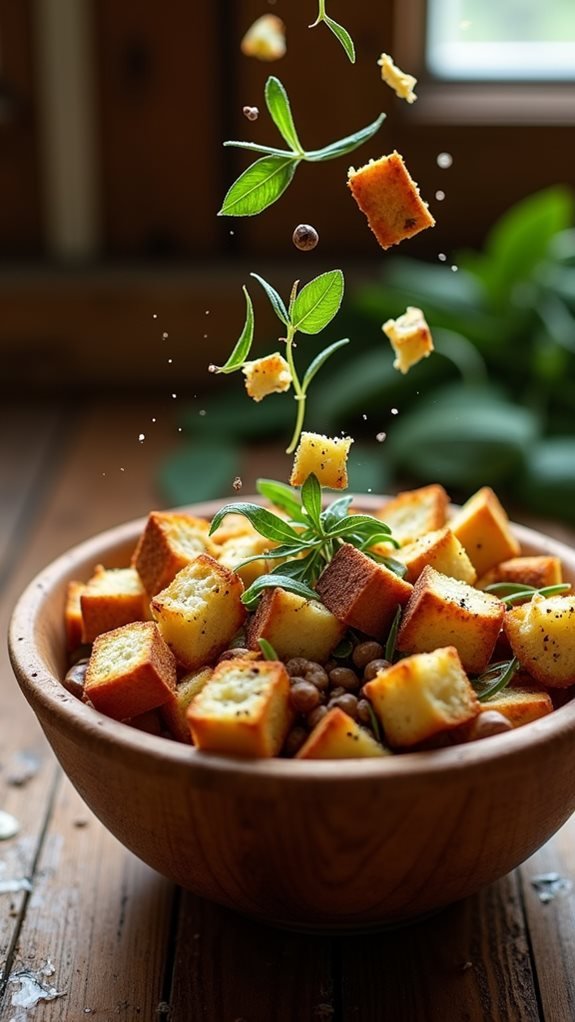
After your bread is perfectly toasted in sage butter, it’s time to bring all components together in your baking dish. Transfer the golden-brown bread cubes to a large, deep baking vessel, ensuring they’re evenly distributed across the bottom. You’ll want to create a solid foundation for the remaining ingredients.
Now, scatter the roughly chopped chestnuts throughout the bread mixture, making sure they’re evenly distributed. As the stuffing bakes, the chestnuts will infuse their subtle sweetness into every bite.
Take your crispy sage leaves and crumble them over the top, allowing their intense aromatics to disperse throughout the dish.
Next, yarefully pour the warm chicken stock over everything. Start by adding it gradually in a circular motion, giving the bread time to absorb each addition. You want the bread to be thoroughly moistened but not swimming in liquid —it should feel like a damp sponge when gently pressed.
Once you’ve achieved the right consistency, cover the dish with foil, sealing it tightly around the edges to trap the moisture during baking.
Step 4. Bake Covered With Foil
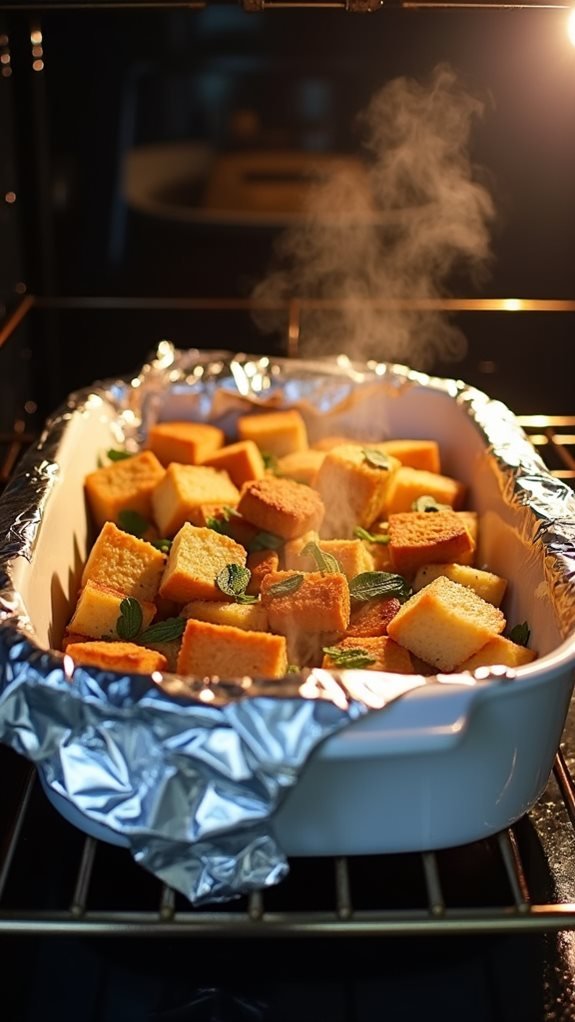
The next stage of creating your perfect stuffing takes place in the oven. Preheat to 375°F while you’re transferring your prepared mixture into a large, deep baking dish. You’ll want to spread the ingredients evenly to ensure uniform cooking throughout.
Cover the dish tightly with aluminum foil, making sure there aren’t any gaps where steam could escape during the initial baking phase.
Place your covered dish on the middle rack and let it bake for 30 minutes. This covered period allows the flavors to meld together while the stock gradually permeates the bread cubes without drying them out. You’ll notice the stuffing becoming more cohesive as the liquid is absorbed, creating that perfect balance between moistness and structure.
After the initial baking time, carefully remove the foil – watch out for hot steam – and return the dish to the oven for an additional 15 minutes. This final uncovered bake will create that irresistible golden-brown crust on top while maintaining a tender, flavorful interior that your guests will love.
sStep5. Bake Uncovered Until Crispy
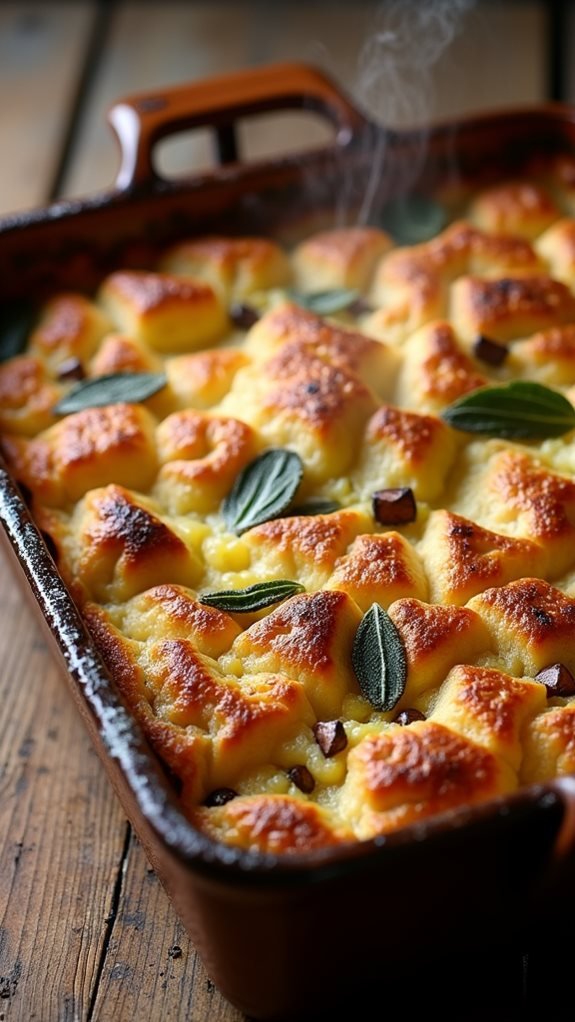
Once you’ve removed the foil, your stuffing enters its final critical cooking phase. This pivotal 15-minute period transforms the top layer into a golden-brown crust while maintaining the moisture below. You’ll want to watch carefully as the exposed bread cubes begin to crisp and darken, ensuring they don’t burn.
During this uncovered baking stage, you’re developing what chefs call textural contrast – a crispy top layer that gives way to the tender, flavorful interior. If you notice certain areas browning faster than others, rotate your baking dish for even cooking.
You’ll know your stuffing is ready when the surface has reached a deep golden color and feels firm to the touch.
Don’t be tempted to rush this final stage by increasing the temperature. The steady 375°F allows the top to crisp gradually while the flavors continue to meld underneath. If your top layer starts to darken too quickly, you can loosely tent it with foil while allowing some edges to remain exposed, ensuring you’ll still achieve that perfect contrast of textures.
Common Questions About This Recipe
Many home cooks ask similar questions while preparing this chestnut and sage sourdough stuffing for the first time. Getting the perfect texture depends on properly dried bread, so if you’re short on time, you can speed up the process by cutting the bread into cubes and drying them in a 250°F oven for 45 minutes, stirring occasionally.
If you’re wondering about make-ahead options, you can prepare the components up to two days in advance. Toast the bread cubes, roast the chestnuts, and store them separately in airtight containers. You’ll want to wait until the day of serving to combine everything with the stock and complete the final bake.
For those asking about substitutions, you can replace chestnuts with pecans or walnuts, though you’ll lose some of that distinctive holiday flavor. When considering the chicken stock, vegetable stock works well for a vegetarian version, but you’ll need to adjust the salt accordingly.
If your stuffing seems dry during baking, don’t hesitate to add an extra splash of warm stock to reach your desired consistency.
Final Thoughts and Serving Ideas
Successfully plating and serving this chestnut and sage sourdough stuffing makes all the preparation worthwhile. You’ll want to present this dish in a warm, rustic ceramic baking dish that complements its golden-brown top and allows guests to serve themselves easily. The stuffing’s aroma of sage and roasted chestnuts will draw everyone to the table.
For the perfect presentation, garnishing with fresh sage leaves and a few whole roasted chestnuts adds visual appeal without overwhelming the dish. If you’re serving a larger gathering, consider making two smaller batches instead of one large one—this guarantees everyone gets those coveted crispy edges.
You can keep the stuffing warm in a low-temperature oven (200°F) for up to 30 minutes before serving but don’t cover it, as this will soften the crispy top. When it’s time to serve, provide a wide spoon that can capture both the crispy top and tender interior. This stuffing pairs beautifully with turkey, rand roasted chicken, or even as a standalone vegetarian main when served with roasted vegetables and gravy.
